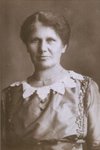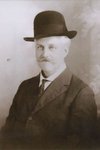







After the scares of the 1855-56 Indian Wars, Pacific Northwest settlers abandoned most of the nearly four dozen forts and blockhouses. But Elkanah and Laurinda Vianna Mills sold their home on Mud Mountain southeast of Chehalis and, with their daughter and son-in-law, Robert and Mary Jane (Mills) Brown, stayed on Sidney Ford’s farm.
“After the close of the war, Father and Robert Brown, my husband, rented Judge Ford’s farm for five years,” Brown wrote in the early 1900s. “We stayed (on Fords Prairie) three years and then moved on our own farm and lived there 33 years where most all of my sixteen children were born and all but the three youngest grew to men and women.”
In 1858, Robert and Mary Jane (Mills) Brown, who had been married six years, bought the land claim of Petersen Luark in the Skookumchuck area and settled there to raise their large family. Like her mother, Laurinda, Mary Jane practiced as a nurse and midwife to help their neighbors.
Her father, Elkanah Mills, a miller and butcher, moved to Claquato and ran the Astor House Hotel for eight years before taking up a homestead on the banks of the Chehalis River in 1867 southwest of Centralia, near where Providence Centralia Hospital is today. He served with James Cochran (Centralia founder George Washington’s adoptive father) and J.W. Goodell on a board to locate a territorial road from Cowlitz Landing near present-day Toledo to Olympia. He and Laurinda Vianna (Wisdom) Mills had 11 children, among them Mary Jane, George Washington, John T., William Perry, Joseph Moses, Samuel Thurston, Lizzie, and Mandana Susanna (Mills) Shriver.
After the death of her husband in May 1891 at the age of 66, Mary Jane (Mills) Brown moved to Gate, Washington, an unincorporated community in Thurston County northwest of Rochester, where her three youngest children lived.
“Now I am alone, but some of them come to see me every day,” she wrote.
Her father had just turned 74 in December 1892 when he died the following year, in January. He was buried in the Pioneer Cemetery at Mountain View Cemetery in Centralia. Her mother, Laurinda Vianna (Wisdom) Mills, died seven years later at the home of her son, Samuel, and was buried beside her husband. She was about 82.
Like Mary Jane, Samuel, who was born in 1852, had a large family of 13 children. Many of the Mills’ children and grandchildren played the fiddle, mouth organ, or other instruments as part of the Mills Brothers band, which performed at dances throughout the region for more than 80 years.
The expansive progeny of the Mills and Brown families was referenced in the book, “Centralia: The First Fifty Years: 1845-1900.” “One can understand the friendly warning heard often in later years, ‘Be careful what you say about a Mills or a Brown, because you may be talking to one.’”
Mary Jane Mills Brown, who was born in Polk County, Missouri, on Sept. 27, 1838, was known throughout the region as “Grandma Brown.” She attended the annual Pioneer Picnic Day in Rochester, her only public appearance each year, where she was crowned Mother Queen of the Southwest Washington Pioneers.
“Other times she was to be found at a spotlessly clean home ‘picking up things,’ tending to flowers and always ready for conversation,” according to a May 8, 1930, Centralia Daily Chronicle article about her death. “Her mind ever remained clear, and she was unceasingly active up to the day of her death.”
Mary Jane (Mills) Brown died May 5, 1930, at the age of 92.
“In her last years she had outlived all who had accompanied her across the plains in 1847,” the newspaper reported. “Her pioneer friends, chief among whom was ‘Uncle Johnnsy’ James, who passed away in April 1929, had departed most of them many years ago.”
A dozen of her 16 children were still living when she passed away. Among Robert and Mary Jane’s children were Ellen Vienna (Brown) Ormsby, Thomas Elkanah Brown, David Wilson Brown, John Lincoln, Brown, Henry Ellsworth Brown, Logan Robert Brown, Ester Mary (Brown) Grant, Roy Lycurgis Brown, Helena Mable (Brown) Larsen, and Lawrence Wisdom Brown.
At the time of her death in 1930, Mary Jane Brown was survived by 47 grandchildren, 55 great-grandchildren, and five great-great-grandchildren.
“She's buried at Grand Mound Cemetery, her husband at Mountain View,” said Greg Isaacson of Chehalis, a friend of Larry Mills, who was a descendant of Elkanah Mills’s brother, William. “The story goes that she wanted to be buried in a separate place so she wouldn’t have any more children!”
Mills Palmer Place Preserves Pioneer Legacy
Today, just south of U.S. Highway 12 a mile east of Rochester, lies nearly 30 acres of endangered towering white oak, firs and other trees, brush and wetlands nestled around Scatter Creek’s main stem, land provided as a permanent greenbelt to protect the land and honor two pioneer families.
Larry Mills, a Centralia native born in 1937 who grew up in Rochester and died at a Des Moines, Washington, hospital Nov. 30, 2020, provided the Mills Palmer property to the Heernett Environmental Foundation for perpetual preservation. According to a sign on the property, “This reach of Scatter Creek has critical salmonoid habitat and native White Oak riparian areas.”
The land can serve as an outdoor classroom for local students, offering a glimpse of what the Pacific Northwest looked like when Mills’s ancestors traveled west and settled in the region in the 1850s.
In 1976, Isaacson married Jody Rae Anderson, whose mother (Eleanor Peterson) was Larry’s first cousin. The friendship between the two men lasted more than four decades as Isaacson helped Mills track down and restore Studebakers, automobiles produced in South Bend, Indiana, until 1966. Mills belonged to the Tacoma Studebaker Club.
“We found one in Eastern Oregon in a field of hay,” Isaacson recalled. “We took it all apart. I worked on his cars. His goal was to save every Studebaker he could from destruction.”
Isaacson also accompanied his friend to Ohio for a Studebaker. Mills, who owned nine when he passed away, taught grade school in Tacoma for a while and lived on the third floor of a condo there. He also owned other properties in Pierce County that he rented. He never married.
“He smoked like a chimney,” Isaacson said. And he loved stopping at McDonald’s. “One time when he went back to South Bend, Indiana, by himself, he stopped at over 100 McDonald’s.”
Mills also spent money cleaning up the headstones of relatives at the Grand Mound Cemetery, where he was inurned near his parents.
Larry was the great-great-grandson of William Mills, the older brother of Elkanah and namesake of their father. He and his wife, Eliza (Teague) Mills, settled in Thurston County in 1852.
The eldest of William’s five children, Nathaniel, Larry’s great-grandfather, was born in 1839 in Missouri, married Isabelle Kirtley, and fathered four children — James, Martha Ann (Mills) Palmer, Sophia Minter (who died at 16), and Lola May (who died at a year old). Nathaniel passed away in 1916 and his wife died nine years later.
The greenbelt honors both of Nathaniel’s surviving children — James William “Uncle Jim” Mills and Martha Ann (Mills) Palmer.
Jim and his wife, Bina, had only one child, Walter Everett Mills, who was born in 1896 and lived in the Rochester area, except while in the Army during World War I. Walter served as a police justice judge in the early 1900s and a Thurston County commissioner for four terms. He and his wife, LeNora (Mashburn) Mills, also had only one child, Larry.
As a bachelor and only child, he inherited everything from his parents.
And he gave some away to ensure an ongoing legacy for his family.
•••
Julie McDonald, a personal historian from Toledo, may be reached at memoirs@chaptersoflife.com.